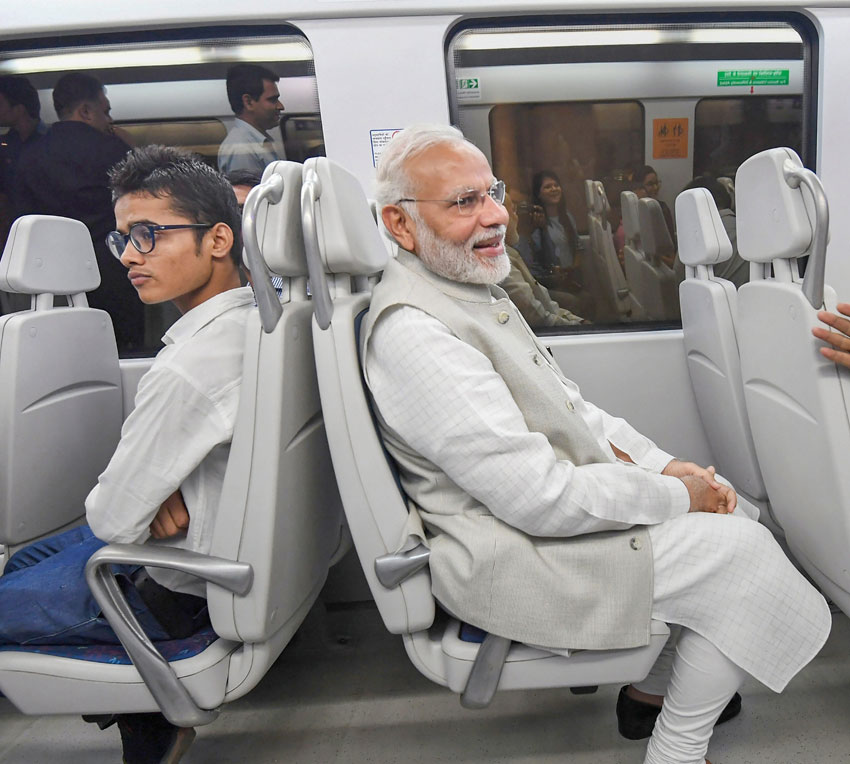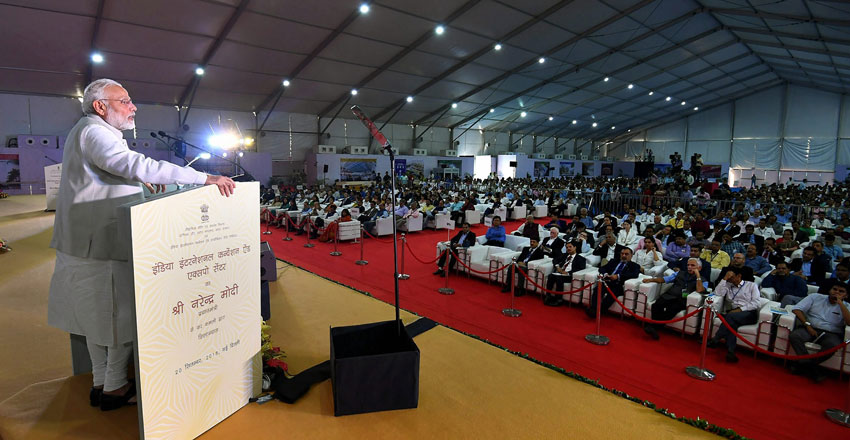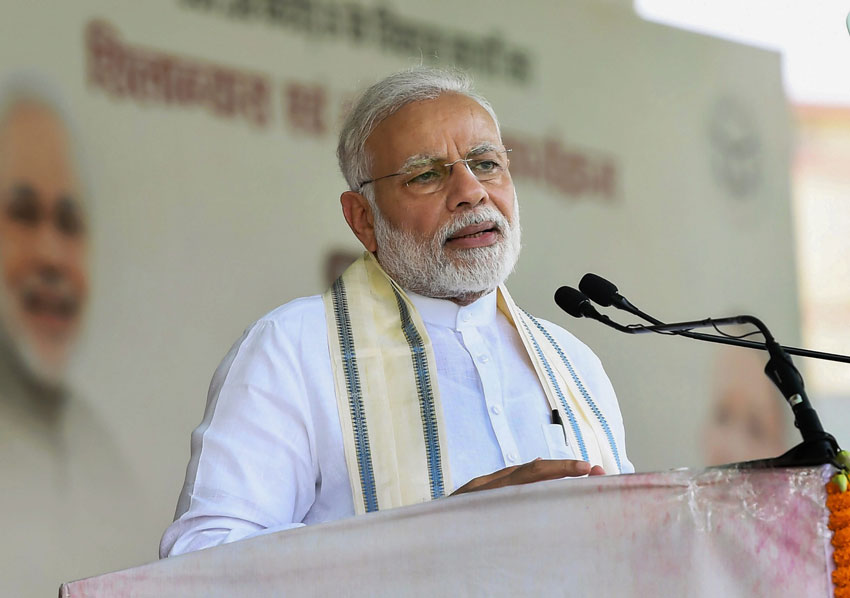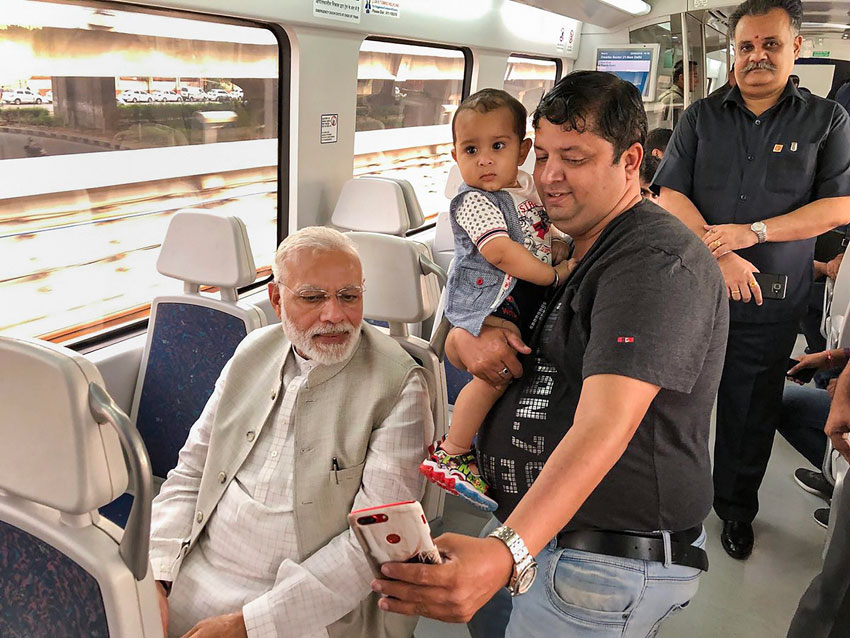Indian Gov’t Will Continue to Take Tough Decisions, Says PM Modi
Indian Prime Minister Narendra Modi travels in Airport Express Metro Line to reach the venue of the foundation stone laying ceremony of India International Convention and Expo Center at Dwarka, in New Delhi, Sept. 20. (PMO/PTI)
Prime Minister Narendra Modi said that his government will continue to take tough decisions and expressed hope, Sept. 20, that the size of the Indian economy will double to $5 trillion in the next five-seven years.
The contribution of manufacturing and agriculture would be $1 trillion each, he said, while laying the foundation stone of India International Convention and Expo Center (IICC), in New Delhi.
Modi traveled by the Airport Express Metro to reach the venue of the foundation stone laying ceremony at Sector 25, Dwarka.

“I want to assure you that in the public interest, we have taken tough decisions and this will continue,” he said, adding India’s economy is gaining strength despite global challenges.
The economy, he added, is growing at over 8 per cent and in the “next five-seven years, size of the economy will touch USD 5 trillion and will rise further to USD 10 trillion in the next decade”.
Modi further said that the government has recently taken a decision to merge Dena Bank, Vijaya Bank with the Bank of Baroda.
“What is the need of dozens of public sector banks. We have been listening to this debate for years but no one took steps in that direction,” the prime minister said, adding the government has also merged banks with SBI and has now decided to merge three more state-owned banks.
Referring to the government’s Make in India initiative, he said India has become a hub of mobile phone manufacturing, which has provided employment to 4-5 lakh youth in the last four years and has helped the country save Rs 3 lakh crore foreign exchange.
The government, Modi said, is preparing district-level plans to promote ease of doing business so that they can increase their contribution to the national gross domestic product.
Tourism sector too has recorded healthy growth and has created job opportunities for youth, he added.
Talking about the Rs 25,703-crore convention centre, the prime minister said it would help create jobs for 5 lakh youth.
He said that several countries have emerged as a hub for conference tourism but in India, nobody has thought in this direction.
Now, the government is working in this direction and developing this convention and expo centre with a sitting capacity of 10,000 people, he said, adding this centre would reflect India’s economic progress and rich cultural heritage.
He also said it is a part of the government’s vision which gives importance to world-class infrastructure, and ease of doing business.
He added that this government has built the longest tunnel, the longest gas pipeline, the largest mobile manufacturing unit, and electricity to every household among many others projects.

The centre would help in promoting startups, industries, improve ease of living for people and the MSME sector.
The facilities provided at the centre will be at par with the best in the world in size and quality, offering setting for international and national events, meetings, conferences, exhibitions and trade shows.
The project is planned over an area of 221.37 acres at Sector 25, Dwarka, here at an estimated cost of Rs 25,703 crore.
The IICC will be an integrated complex with facilities like exhibition halls, convention centre, open exhibition spaces, mixed-use commercial spaces like star hotels (5, 4 and 3 stars), retail services and high-end offices.
The convention centre would accommodate up to 11,000 persons, would have five exhibition halls, 1-kilometre long foyer, multi-purpose arena with a retractable roof.
It will be developed in two phases. Phase-I and II will be completed by December 2019 and December 2024, respectively.
WB Endorses CPF for India to Support Its Transition to Higher Middle-Income Country

A day after Prime Minister Narendra Modi said India will become a $5 trillion economy by 2022, the World Bank board endorsed an ambitious five-year Country Partnership Framework (CPF) for India, Sept. 21, which aligns with New Delhi’s objectives of high, sustainable and inclusive growth, writes Lalit K. Jha.
Aimed at supporting India’s transition to a higher middle-income country by addressing some of its key development priorities – resource efficient and inclusive growth, job creation and building its human capital – the framework is expected to bring between $25-30 billion in financial support from the International Bank for Reconstruction and Development (IBRD), the International Finance Corporation (IFC) and the Multilateral Investment Guarantee Agency (MIGA).
“With a fast-growing economy, global stature, and its unique experience of lifting the highest number of poor out of poverty in the past decades, India is well-positioned to become a high middle-income country by 2030,” said Hartwig Schafer, World Bank South Asia vice president.
“It’s a five-year framework that commits the Bank’s engagement in India, both in areas where what we’ll do, how we will work in these areas and the level of financial commitment. This is the first country partnership framework written with India,” Junaid Ahmad, Country Director, World Bank, India, told PTI in an exclusive interview.
“The CPF was preceded by a systematic country diagnostic or SCD that offered a narrative about India. What are the challenges going forward in terms of the growth of India? And what are the challenges that India faces in achieving the twin goals that the World Bank has put for itself, which is reduction in extreme poverty and the increase in shared prosperity,” Ahmad said.
Soon after the World Bank endorsed the CPF for India, Ahmad said, the Board recognises the incredible growth and development of India over the last several decades.
“It recognizes that India has gone from a low-income country status to a low-middle income. And now India is entering the economic transformation from low-middle income to high-middle income (country). This CPS is about how can the Bank support this transition,” he said.
Noting that both the SCD is a highly consultative document, Ahmad said, the CPF is a joint document with the Indian government.
“I complement the World Bank Group for aligning the CPF with India’s development and investment objectives of high, sustainable and inclusive growth,” said Subhash Chandra Garg, Economic Affairs Secretary, in a statement.
Observing that the SCD basically said India’s big story is steady growth from very low several decades back to a steady growth of seven per cent plus, Ahmad said, this document also showed that the growth is quite diversified.
“Some of it is based on export. A lot of it is based on an internal consumption and investment, unlike say China, which is highly export led growth. So India’s is more broad based, diversified growth path,” he said.
“Over time, this growth has become more stable and is resilient. Recently there were shocks on the economy, which included demonetisation and the GST implementation and there was this fall in the growth. But it is now rebounded, and not only has it gone back to seven per cent, this quarter it is at eight per cent,” Ahmad said.
Based on the SCD goal of taking the Indian growth rate to eight per cent plus, the World Bank argued that there were several areas of engagement that were very important: natural resource management, jobs and competitiveness, and human development, he said, adding that the framework addresses these issues.
“The first point we make is India needs to unleash the power of markets and private sector. It needs to leverage private sector and in particular private capital. The challenge for the Bank is how do you take the little amount of money ultimately you’re putting into the country and you go from being a lending bank to being a leveraging bank,” Ahmad said.
He said complementing transformational national programs, the Bank will also develop strategic state partnerships to address state-specific development priorities and support implementation capabilities at the state and the local level.
“The future of India lies in the states of India. The country’s transition to high middle-income status will be determined in large part by the effectiveness of India’s federal compact. In this context, an important focus of the CPF will be to deepen engagement with India’s states and invest in the institutions and capabilities of the states and local governments to address their development priorities,” Ahmad said.
He said the Bank was going for a “Lighthouse India” approach. “Lighthouse India basically means learning from the innovation of the states and sharing with other states. We also recognise that the learning is what India also has to offer the rest of the world. As it goes from low-income to middle-income to high-middle-income, its learning over its development path is going to be very valuable for other nations,” he said.
“The Indian economy has evolved to a level where the private sector can be counted on to close large developmental gaps. Through this the CPF, the WBG will help India leverage additional resources from the private sector to help India realize its full potential,” said Jun Zhang, Country Head, IFC, India.


